KUALA LUMPUR, May 16 – Last year, about 36.7 per cent of Peka B40 beneficiaries were diagnosed with at least one non-communicable disease (NCD).
Based on Peka B40’s 2021 report, hypertension, high cholesterol, and diabetes were the most common underlying diseases reported among low-income beneficiaries of the federal health screening programme.
Nearly six of 10 Peka B40 beneficiaries, or 58 per cent, were overweight or obese. Women had double the number of obesity cases than men, while Malays comprised two-thirds of overweight or obese beneficiaries.
Last year, 101,673 beneficiaries underwent Peka B40 health screenings, a 54 per cent decline from 222,024 screenings in 2020.
In 2021, hypercholesterolemia was newly diagnosed among 29.9 per cent of beneficiaries, while 9.9 per cent and 7.0 per cent were newly diagnosed diabetes and hypertension respectively.
“The prevalence of the newly diagnosed diabetes and hypertension were slightly higher in 2021 compared to the previous year,” said Peka B40’s 2021 report published recently.
In 2020, newly diagnosed diabetes and hypertension cases were at 8.3 and 6.6 per cent of Peka B40 beneficiaries respectively.
Peka B40’s mental health screening in 2021 reported that 0.4 per cent and 0.3 per cent of beneficiaries were diagnosed with depression and anxiety respectively.
“They were those who had never been diagnosed with depression and anxiety before.”
In 2020, about 0.4 per cent and 0.2 per cent of Peka B40 beneficiaries were diagnosed with depression and anxiety respectively.
According to the report, a total of 4,915,686 million Bantuan Sara Hidup (BSH) beneficiaries and their spouses aged above 40 in 2020 were eligible to be screened under the Peka B40 scheme.
This equals to about 15 per cent of Malaysia’s total population (32,867,800 people), with a higher proportion of beneficiaries eligible for Peka B40 from Perlis (21.89 per cent) followed by Perak (21.32 per cent) and Kedah (20.67 per cent).
About 10.49 per cent of eligible Peka B40 beneficiaries are Sabahans and 19.82 per cent Sarawakians.
Earlier, Health Minister Khairy Jamaluddin noted that only 10 per cent of eligible Malaysians got screened under the Peka B40 scheme.
Women Twice More Obesity Than Men, Perak Tops Overweight Or Obesity
From a total of 95,996 Peka B40 beneficiaries, 58 per cent or 55,662 were overweight or obese. Under this category, 34,235 people or 61.5 per cent were female.
The 55,662 beneficiaries comprised 34,748 overweight (62 per cent) and 20,914 obese (38 per cent) individuals.
Women beneficiaries had twice as many obesity cases than men, with 14,592 obese females than 6,322 obese males.
By ethnicity, Malays comprised 67 per cent, or 37,474 of 55,662 overweight or obese beneficiaries; ethnic Chinese (11 per cent), and ethnic Indian (10 per cent).
By state, Perak reported the highest number of overweight or obesity cases at 7,630 individuals, or about 14 per cent of 55,663 overweight or obese beneficiaries, followed by Kedah (13 per cent), Sarawak (11 per cent), and Kelantan (11 per cent).
“Only one-third of our beneficiaries had a normal BMI between 20 to 24 and about 8 per cent of the beneficiaries were underweight at BMI less than 20.”
According to the Peka B40 report, people aged between 40 to 49 have a higher prevalence of obesity, while those above 70 years old have a higher prevalence of underweight.
Peka B40 measured overweight and obesity via BMI: 25 to 29 for overweight and more than 30 for obesity.
Only 26.5 per cent of beneficiaries are physically active, including 28.7 per cent of men and 25 per cent of women.
From the total of 95,996 beneficiaries, 21,707 people or 22.61 per cent were minimally active, while 48,822 people or 50.87 per cent were inactive.
“Almost half of the beneficiaries were inactive. The prevalence of inactivity is almost similar for both genders while those aged 70 and above had a higher prevalence of inactivity.”
The overall prevalence of smokers in 2021 was 11.7 per cent (11,216 people) of 95,996 beneficiaries.
“The highest age specific prevalence was among those aged 40 to 49 at 17.8 per cent.”
Health Screenings Plummeted During Pandemic
Health screening is the most important objective of Peka B40, mainly to detect NCDs in order to treat the illnesses at a lower cost while allowing early intervention.
Peka B40’s health screening trend showed a sharp decline in visits in March 2020. Visits for health screenings dropped about 52 per cent from 49,422 first visits in December 2019 to 23,855 first visits in March 2020, due to the Covid-19 pandemic.
Since then, monthly first visits did not even reach 20,000 until the end of 2021. Last year, 13,565 first visits were recorded in March – the highest number of first visits recorded in 2021. This fell to 7,897 visits in December.
“Peka B40 beneficiaries screened have lower uptake as compared to the previous year,” the report mentioned.
“This is because of the impact of rising Covid-19 cases and multiple phases of MCO (Movement Control Order) that restricted the beneficiaries to come forward for screening despite continuous promotional engagement and awareness campaigns conducted during this period.”
Each Peka B40 beneficiary is required to undergo two health visits under the health screening programme of this scheme.
Of 101,673 beneficiaries who went for their first health screening visit, 58.4 per cent (59,372 people) were female.
During the first visit, each beneficiary undergoes a consultation to identify their health history, followed by physical examination, mental state assessment as well as urine and blood assessment.
During the second visit, lab test results will be reviewed and beneficiaries will undergo consultation and referral if there is an indication that they require further management.








